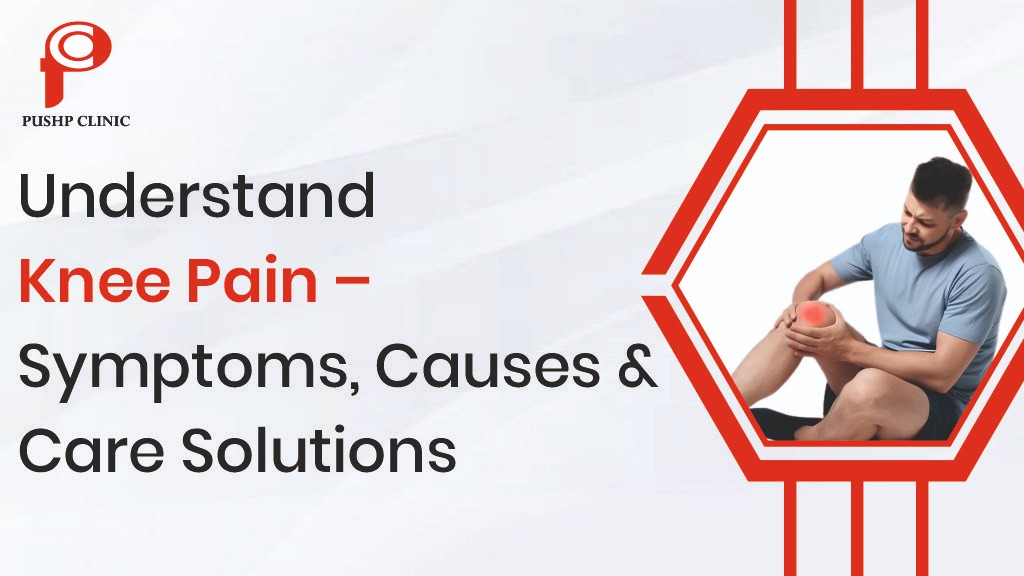Knee pain is a widespread health concern that affects people across all age groups.. From young athletes to older adults, almost everyone experiences some form of knee discomfort at least once in their life. The pain may be temporary, caused by carrying the body’s weight, or long-lasting due to conditions like arthritis or injuries. Because the knee supports most of the body’s weight. Even mild pain can make simple tasks like climbing stairs or getting out of a chair become difficult.
What Is Knee Pain?
The knee is a complex joint made up of bones, cartilage, ligaments, tendons, and the kneecap. It allows bending, straightening, and bearing weight. When any part of this joint is injured or stressed, it can cause discomfort or pain.
Doctors often use terms like ACL injury, meniscus tear, patellofemoral pain syndrome, chondromalacia patella, and osteoarthritis. Understanding these helps in knowing why the knee hurts and what treatment may be needed.
Symptoms of Knee Pain
Knee pain doesn’t feel the same for everyone. Its severity and pattern often depend on the cause. Some of the most commonly reported symptoms include:
- Swelling and stiffness around the joint.
- Pain when walking, bending, climbing stairs, or standing up.
- Redness and warmth, indicating inflammation.
- Popping, clicking, or grinding sounds in the joint.
- Weakness or instability, where the knee feels like it may give way.
- Difficulty straightening or bending the leg completely.
If these symptoms last for more than a week or worsen, medical advice should be sought to rule out serious conditions.
Causes of Knee Pain
1. Injuries
- Ligament tears (ACL, MCL, PCL) – often from sports or accidents.
- Meniscus tear – occurs when twisting the knee under pressure.
- Fractures – from falls or trauma.
- Patellar dislocation – kneecap shifting out of place.
2. Medical Conditions
- Osteoarthritis – degeneration of cartilage causing stiffness.
- Rheumatoid arthritis – autoimmune inflammation of the joint.
- Gout – uric acid crystal buildup causing sudden pain.
- Bursitis – inflammation of fluid-filled sacs cushioning the knee.
- Chondromalacia patella – cartilage breakdown behind the kneecap.
3. Lifestyle Factors
- Excess weight – increases pressure on knees.
- Overuse injuries – from running, squatting, or heavy lifting.
- Weak muscles – due to sedentary lifestyle.
- Poor posture or walking style – adds strain to the joint.
When to See a Doctor
Some cases of knee pain are minor and improve with rest, but others require immediate medical attention. You should consult a doctor if:
- The knee is severely swollen or red.
- You heard a popping sound during an injury.
- You cannot bear weight on your leg.
- Pain continues despite home remedies.
- The joint locks, feels unstable, or loses mobility.
Diagnosis of Knee Pain
Doctors use a variety of methods to identify the cause:
- Physical examination – checking swelling, stability, and movement.
- X-rays – detect fractures or arthritis.
- MRI scans – show soft tissue injuries like ligament or cartilage tears.
- CT scans – give detailed images for deeper analysis.
- Blood tests – confirm infections, gout, or autoimmune issues.
- Arthroscopy – minimally invasive test with a small camera to examine the joint.
Treatment Options for Knee Pain
Home Remedies & Lifestyle Care
- RICE Method (Rest, Ice, Compression, Elevation).
- Heat therapy for stiffness.
- Low-impact exercises like cycling or swimming.
- Weight control to reduce pressure.
- Anti-inflammatory foods such as turmeric, ginger, nuts, and leafy greens.
Medical Treatments
- Painkillers and NSAIDs (ibuprofen, paracetamol).
- Corticosteroid injections for inflammation relief.
- Hyaluronic acid injections to improve lubrication.
- Physiotherapy for strengthening and flexibility.
Surgical Treatments
- Arthroscopy to repair minor damage.
- Partial or Total Knee Replacement for severe arthritis.
- ACL Reconstruction for ligament tears.
Preventing Knee Pain
Prevention focuses on maintaining joint health:
- Stay active with exercises that strengthen muscles around the knee.
- Warm up before sports and workouts.
- Wear supportive shoes.
- Avoid repetitive stress and overtraining.
- Maintain a healthy body weight.
- Try yoga or stretching to improve flexibility.
Key Insights & Data
- WHO reports osteoarthritis as a major cause of disability worldwide.
- In India, nearly 1 in 5 adults suffers from knee pain, with higher prevalence among women.
- More than 200,000 knee replacement surgeries are performed annually in India, and the numbers are increasing.
These figures highlight the need for awareness, early diagnosis, and lifestyle management.
Conclusion
Knee pain can be caused by injuries, arthritis, lifestyle habits, or medical conditions. While mild discomfort may improve with rest and home care, chronic or severe cases need medical attention. With the right combination of home remedies, medical treatments, or surgery, most people can regain mobility and live pain-free.
If your knee pain is persistent, consult an orthopedic specialist. Addressing the problem early prevents complications and ensures long-term joint health.
